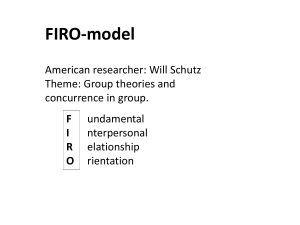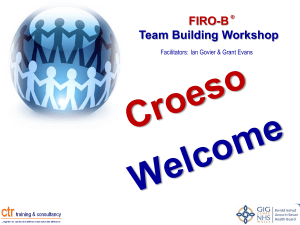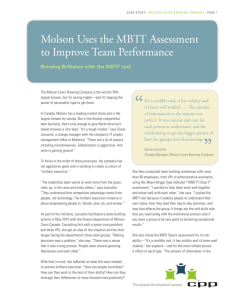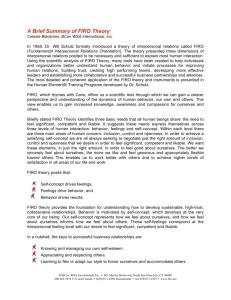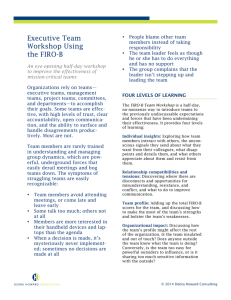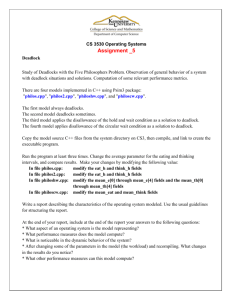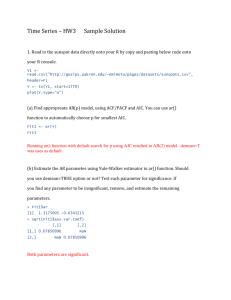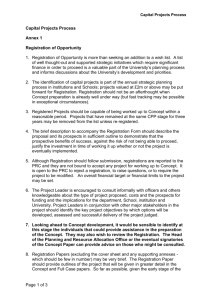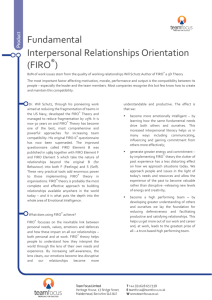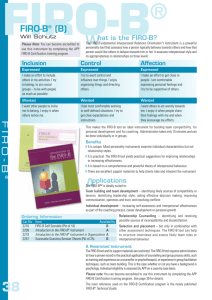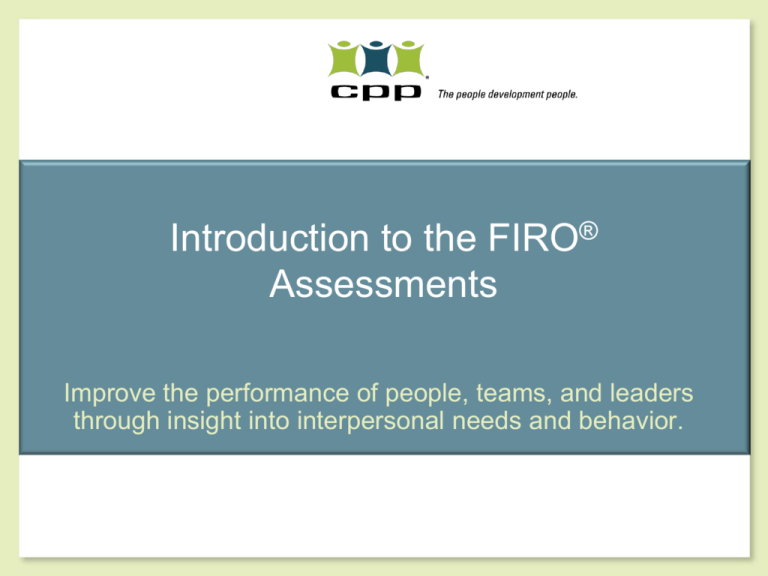
Introduction to the FIRO®
Assessments
Improve the performance of people, teams, and leaders
through insight into interpersonal needs and behavior.
Topics Covered
FIRO® Assessment Overview
Key Applications and Scenarios
Customer Successes
Getting Started
Popular Products
Support Resources
© 2011, CPP, Inc. All rights reserved
2
FIRO® Assessment Overview
FIRO® Assessment Overview
FIRO-B®: Fundamental Interpersonal
Relations Orientation–Behavior™
Original purposes of Schutz’s FIRO-B assessment:
To construct a measure of how an individual behaves in interpersonal
situations
To construct a measure that will lead to a prediction of interaction
between people
4
FIRO® Assessment Overview
Over the years, practitioners have expanded these original
purposes of the assessment to include
Establishing the individual’s level of satisfaction from interpersonal
dynamics
Predicting who will work well together
Identifying possible areas of incompatibility between people
Appreciating and capitalizing on personal strengths and style, as well
as the differing strengths and style of others
Learning how to monitor and vary interaction style with others
5
FIRO® Assessment Overview
The FIRO assessment is based on social need theory:
All living things seek equilibrium between their basic needs and getting
those needs met
If needs get met at the desired level, equilibrium exists
If needs are not met, discomfort/anxiety rises
In FIRO terms, the three basic needs are for
– Inclusion/Involvement
– Control/Influence
– Affection/Connection
The three needs are assessed in two dimensions:
– Expressed needs: How much we prefer to initiate the behavior toward
others
– Wanted needs: How much we prefer others to initiate the behavior
toward us
6
FIRO® Assessment Overview
FIRO-B results at a glance
Six FIRO-B scales,
six FIRO-B totals
Each score and total—
considered individually and
in comparison—has
interpretive meaning
Source: FIRO-B® Profile, (Mountain View, CA:
CPP, Inc., 2003).
7
FIRO® Assessment Overview
Development of the FIRO Assessment
1952
1978
1994
Initial work conducted for Naval Research Labs
FIRO-B assessment first published by CPP, Inc.
Introduction to the FIRO-B® Instrument and Introduction to
the FIRO-B® Instrument in Organizations client booklets
published
1998
Leadership Report Using the FIRO-B® and MBTI®
Instruments published
2000
Participating in Teams client booklet and
FIRO-B® Technical Guide published
2009-10 FIRO Business® assessment, reports, and client and
practitioner booklets published
8
FIRO Business®—An Evolution
Shorter instrument: 54 items reduced to 30
Fewer repetitive items: Guttman scoring method replaced
with Likert-type scales
Introduces a business voice:
• Inclusion
• Control
• Affection
Involvement
Influence
Connection
Scoring sample normed in 10 languages
Raw scores now reported as percentiles
9
Key Applications and Scenarios
Key Applications and Scenarios
Team Building
Leadership and Executive Development
Conflict Management
Individual Development
Applied Emotional Intelligence (EQ)
11
Key Applications and Scenarios:
Team Building
Workshop activity from
Participating in Teams
(Schnell, 2000)
FIRO-B verification exercise
This exercise also translates
the FIRO-B Overall Need
score to comfort with teams
Exercise tables provide full
range of meaning for Overall
Need score
Source: Eugene R. Schnell, Participating in Teams, (Mountain
View, CA: CPP, Inc., 2000).
12
FIRO® Assessment Overview
FIRO-B results at a glance
Six FIRO-B scales,
six FIRO-B totals
Each score and total—
considered individually and
in comparison—has
interpretive meaning
Source: FIRO-B® Profile, (Mountain View, CA:
CPP, Inc., 2003).
13
13
Key Applications and Scenarios:
Team Building
Workshop activity from
Participating in Teams
(Schnell, 2000)
FIRO-B verification exercise
Applies FIRO-B Overall
Need score to comfort with
teams
Provides full range of
meaning for Overall Need
score
Source: Eugene R. Schnell, Participating in Teams, (Mountain
View, CA: CPP, Inc., 2000).
14
Key Applications and Scenarios:
Team Building
In this exercise, workshop participants
Mark their Overall Need score on the number line
Confirm the corresponding proposals about their
level of comfort working with teams
Source: Eugene R. Schnell, Participating in Teams, (Mountain
View, CA: CPP, Inc., 2000).
15
Key Applications and Scenarios:
Team Building
Workshop activity from
Participating in Teams
(Schnell, 2000)
FIRO-B verification exercise
Applies FIRO-B Overall
Need score to comfort with
teams
Provides full range of
meaning for Overall Need
score
Source: Eugene R. Schnell, Participating in Teams,
(Mountain View, CA: CPP, Inc., 2000).
16
Key Applications and Scenarios: Leadership
Report page from FIRO-B®
Interpretive Report for
Organizations
Applies FIRO-B highest
and lowest Expressed
Need score to illustrate
leadership style
One of three distinct
leadership styles proposed
Source: Allen L. Hammer and Eugene R. Schnell, FIROB® Interpretive Report for Organizations, (Mountain View,
CA: CPP, Inc., 2007).
17
Key Applications and Scenarios:
Conflict Management
Workshop activity 7 from
Participating in Teams
(Schnell, 2000)
Based on W. Schutz’s
compatibility theory
Source of many workshop
―aha!‖ moments
Source: Eugene R. Schnell, Participating in Teams, (Mountain
View, CA: CPP, Inc., 2000).
18
Key Applications and Scenarios:
Conflict Management
Workshop activity 7 from
Participating in Teams
(Schnell, 2000)
7
1
7
Based on W. Schutz’s
compatibility theory
Source of many workshop
―aha!‖ moments
Source: Eugene R. Schnell, Participating in Teams, (Mountain
View, CA: CPP, Inc., 2000).
19
Key Applications and Scenarios:
Conflict Management
Workshop activity 7 from
Participating in Teams
(Schnell, 2000)
7
1
7
Based on W. Schutz’s
compatibility theory
Source of many workshop
―aha!‖ moments
7
9
7
Source: Eugene R. Schnell, Participating in Teams, (Mountain
View, CA: CPP, Inc., 2000).
20
Key Applications and Scenarios:
Conflict Management
Workshop activity 7 from
Participating in Teams
(Schnell, 2000)
7
1
7
7
9
7
Based on W. Schutz’s
compatibility theory
Source of many workshop
―aha!‖ moments
7
9
7
Source: Eugene R. Schnell, Participating in Teams, (Mountain
View, CA: CPP, Inc., 2000).
21
Key Applications and Scenarios:
Conflict Management
Workshop activity 7 from
Participating in Teams
(Schnell, 2000)
7
1
7
7
9
7
Based on W. Schutz’s
compatibility theory
Source of many workshop
―aha!‖ moments
7
9
7
7
1
7
Source: Eugene R. Schnell, Participating in Teams, (Mountain
View, CA: CPP, Inc., 2000).
22
Key Applications and Scenarios:
Individual Development
According to Schutz and FIRO theory, is there an ideal way to be?
■ Yes! Be honest with self/others about who you are and the frequency and
intensity of what you need in order to thrive
■ Be mindful and considerate of others: ask what they need, and flex to deliver
■ Have enough interaction to avoid isolation, but not too much, so as to avoid
entanglement
■ Have enough influence to determine your own future, but know when to lean on
others and let them teach you/lead the way
■ Have enough closeness without getting smothered, but not so little that
relationships become impersonal and distant
23
Key Applications and Scenarios: Applied EQ
FIRO Business® Profile Report,
p. 4
Shows percentile scores
Presents interpretive proposal
of scores
Source: FIRO Business® Profile, (Mountain View, CA: CPP,
Inc., 2009).
24
Customer Successes
Customer Successes
―Our patients depend on us for high-quality, compassionate care. To
accomplish this, we must develop strong leaders. The FIRO instrument
supports our efforts.‖
—Joan Evans, Director of Organizational Development, Moses Cone Health System
―CPP assessments [including the FIRO-B assessment] will continue to help us
find new ways to overcome bureaucratic hurdles and get people to think and
work in ways that improve the ability of the Air Force to defend our country.‖
—Blaise J. Durante, U.S. Air Force Deputy Assistant Secretary for Acquisition Integration
26
Getting Started
Getting Started
CPP offers fast, easy, convenient assessment administration,
scoring, and reporting through
SkillsOne.com, our secure and
efficient Web-based delivery
platform
Paper-and-pencil version of the
FIRO-B assessment
28
Getting Started
You can become eligible to purchase and use the FIRO-B
and FIRO Business assessments through
Completion of the FIRO® Certification Program
− Available exclusively through CPP as an on-site program
Completion of the MBTI® Certification Program
− If you are certified on the Myers-Briggs® assessment, you are also eligible to
purchase and use FIRO assessments and reports
− Available through CPP, American Management Association (AMA), and
Center for Applications of Psychological Type (CAPT)
Education
− If you have a master’s degree or higher in psychology, counseling,
organizational development, or a related field, you are considered
educationally eligible for both assessments
29
Popular Products and Support
Resources
Popular Products for the FIRO-B® Instrument
■
FIRO-B® Profile (#220160)
■
FIRO-B® Interpretive Report for Organizations (#210255)
■
Leadership Report Using the FIRO-B® and MBTI®
Instruments (#210256)
■
Coach’s Guide to the Leadership Report Using the
FIRO-B® and MBTI® Instruments (#2621)
■
Introduction to the FIRO-B® Instrument (#2209)
■
Introduction to the FIRO-B® Instrument in
Organizations (#2219)
■
Participating in Teams (#2220)
■
FIRO-B® Technical Guide
■
FIRO-B® and FIRO Business®
Feedback Sessions DVD (#2270-DVD)
(#2225)
31
Popular Products for the FIRO Business® Instrument
■
FIRO Business® Profile (#220170)
■
FIRO Business® Leadership Report (#2501606)
■
FIRO Business® Leadership Report User’s Guide (#2503)
■
Introduction to the FIRO Business® Instrument (#2504)
■
FIRO Business® Technical Guide (#2502)
■
FIRO-B® and FIRO Business® Feedback Sessions DVD
(#2270-DVD)
32
Support Resources
Free support and guidance is an important part of our commitment to you.
Visit www.cpp.com > Knowledge Center to access complimentary case studies,
white papers, webinars, videos, research reports, and a wealth of other resources.
Case Studies
–
–
White Papers
–
―UCSF: Advancing Leadership Skills to Build a Safer Health System‖
―Air Force: Air Force Acquisition Uses Three Key CPP Assessments to Build
Organization-Wide Leadership Ability‖
―Using FIRO Business® in Key Business Applications with the MBTI® Tool‖
Webinars on Demand
–
–
–
―Be Better at Creating Powerful People: Building Trust and Creating Influence
Through Behavioral-Based Coaching‖
―Be Better at Putting It into Action: Promoting a Balanced Organizational
Culture‖
―FIRO Business® Suite of Products‖
Visit www.cpp.com/FIRO to learn more about the FIRO product line.
33
Or contact CPP Customer Service for personal guidance. Our people
look forward to providing you with the expertise and support you
need to be better and succeed.
CPP Customer Service
800-624-1765
custserv@cpp.com
www.cpp.com
© 2011 by CPP, Inc. FIRO, FIRO-B, FIRO Business, Fundamental Interpersonal Relations Orientation–Behavior, SkillsOne, and the FIRO and CPP logos are trademarks or
registered trademarks of CPP, Inc. MBTI and Myers-Briggs are registered trademarks of the MBTI Trust, Inc. For more information to purchase or to request permission to use
the materials featured in this presentation, please visit www.cpp.com.
34

